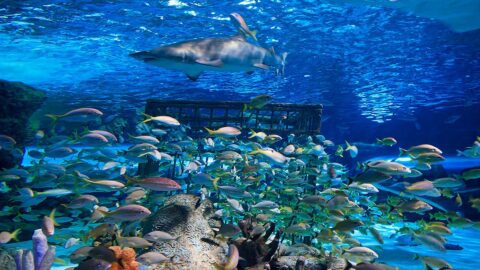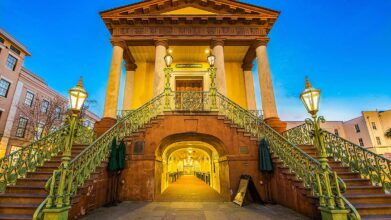South Carolina Aquarium

The South Carolina Aquarium is home to a variety of marine life, including sea turtles, stingrays, and sharks. It also has a rescue center that cares for injured sea turtles before releasing them back into the wild. Located along the waterfront, the aquarium focuses on education and conservation. Interactive exhibits allow visitors to get up close with animals and learn about South Carolina’s coastal ecosystems.
History of South Carolina Aquarium
The South Carolina Aquarium in Charleston officially opened to the public on May 19, 2000. From the start, its mission has focused on inspiring conservation of the natural world through animal care, education and research. Located along the edge of Charleston Harbor, the aquarium was designed to highlight the rich biodiversity of South Carolina’s aquatic ecosystems. Its exhibits follow the journey of water from the Blue Ridge Mountains to the Atlantic Ocean, helping visitors understand how all of these environments are connected.
Since opening, the South Carolina Aquarium has become one of the region’s most visited attractions. It is home to thousands of animals, including sea turtles, sharks, river otters, stingrays and native fish species. The aquarium also plays a key role in conservation efforts, most notably through its work rescuing and rehabilitating injured sea turtles. In addition to its animal care and exhibits, the aquarium offers a wide range of educational programs for schools, families and the general public, all centered on the importance of protecting South Carolina’s unique natural habitats.
South Carolina Aquarium Fun Facts
The Great Ocean Tank is the deepest aquarium tank in North America.
At 42 feet deep and holding more than 385,000 gallons of water, the Great Ocean Tank is the largest exhibit at the South Carolina Aquarium. It’s home to more than 500 animals, including nurse sharks, sand tiger sharks, sea turtles and stingrays. The tank spans two floors, giving guests a chance to view the marine life from multiple angles. Daily dive shows offer an up-close look at how staff care for the animals and feed them throughout the day.
The aquarium focuses entirely on South Carolina’s native ecosystems.
The South Carolina Aquarium is unique in that it centers its entire exhibit experience on wildlife found across the state. Guests move through galleries that reflect real environments, from the cool streams of the Blue Ridge Mountains to the tidal creeks and salt marshes of the Lowcountry. This regional focus gives visitors a stronger sense of place and a deeper connection to the species they might encounter in their own communities.
Sea turtle rehabilitation is a core part of the mission.
The Zucker Family Sea Turtle Recovery is a real hospital inside the aquarium. Here, guests can see veterinarians and marine biologists treating injured sea turtles, many of which arrive with injuries from boats, entanglement in plastic or cold-stunning. Interactive displays explain the causes of these injuries and how the public can help prevent them. Since opening, the South Carolina Aquarium has helped hundreds of turtles return to the ocean.
A rescued bald eagle named Liberty calls the aquarium home.
In the Mountain Forest exhibit, you’ll find Liberty, a bald eagle that was rescued after sustaining a permanent wing injury. She’s unable to survive in the wild, but now serves as an ambassador for Appalachian wildlife. Her habitat reflects the forested regions of the state and reminds visitors that the South Carolina Aquarium showcases far more than marine life. It highlights the full range of ecosystems that shape South Carolina’s natural landscape.
More than just sea creatures live here.
The South Carolina Aquarium also houses native reptiles, amphibians and mammals that play a vital role in local ecosystems. American alligators, nonvenomous snakes, a gopher tortoise and lively river otters named Charlie and Beau can be found in various exhibits. These animals help illustrate how land and water habitats are deeply connected, and they’re a favorite among children and families.
The aquarium has earned national recognition.
In 2019, the South Carolina Aquarium received the National Medal for Museum and Library Service, the highest honor a museum in the U.S. can receive. The award recognized its ongoing efforts in marine conservation, public education, and community engagement. Through programs like field trips, outreach visits, and citizen science projects, the aquarium continues to make a lasting impact both inside and outside its walls.
There are more than 10,000 animals to discover.
Visitors to the South Carolina Aquarium will encounter over 10,000 animals representing a wide range of species. From colorful reef fish and jellyfish to flounders and seahorses, each exhibit is carefully designed to reflect real environments across the state. New animals and rotating exhibits help ensure that no two visits are exactly the same.
Octopuses at the aquarium have three hearts and blue blood.
Octopuses remain one of the most popular and intriguing animals at the South Carolina Aquarium. With three hearts and copper-rich blue blood, their biology is unlike anything else on display. Guests can often watch them change color, squeeze into tight spaces or interact with enrichment tools provided by aquarists. These animals help spark curiosity and demonstrate the incredible diversity of life under the sea.
Know Before You Go
Planning ahead can make your visit to the South Carolina Aquarium even more enjoyable. Here are a few tips and details to help you prepare before heading to this popular Charleston attraction.
Purchase tickets in advance online.
The South Carolina Aquarium encourages visitors to buy tickets ahead of time through its official website. This helps reduce wait times and guarantees your spot, especially during weekends, holidays and spring break. Purchasing online also allows you to view the daily schedule and plan around any special programs or events.
Timed entry is required.
The aquarium operates on a timed entry system, which means guests choose a specific arrival window when purchasing tickets. This system helps manage crowd flow and ensures a more comfortable experience for everyone. Be sure to arrive during your scheduled time, and keep in mind that re-entry is not permitted.
Hours of operation are consistent year-round.
The South Carolina Aquarium is typically open daily from 9:00 a.m. to 5:00 p.m., with the last ticketed entry allowed at 3:30 p.m. While rare closures may occur for holidays or severe weather, the schedule is consistent throughout the year. Checking the official website before your visit is a good way to confirm current hours.
Weekday mornings are the best time to visit.
To avoid the largest crowds, consider visiting the aquarium on a weekday morning. Early arrival not only provides a quieter environment but also allows you to enjoy exhibits like the Great Ocean Tank or the touch tanks before they become busier in the afternoon.
The aquarium is fully accessible and stroller-friendly.
The South Carolina Aquarium is designed with accessibility in mind. All exhibit paths accommodate wheelchairs and strollers, and elevators are available to move between floors. Family restrooms and nursing areas are also available, making the facility a convenient option for families with young children or visitors with mobility needs.
Parking is available nearby.
A city-run parking garage is located adjacent to the aquarium at Liberty Square. Standard hourly rates apply, and payment kiosks accept cash or cards. From the garage, it’s a short walk to the main entrance, and there are drop-off zones nearby for added convenience.
Food and drink options are limited.
While there is a small café with snacks and drinks inside the South Carolina Aquarium, full meal options are limited. Guests are encouraged to plan meals before or after their visit. Fortunately, the aquarium’s downtown location places it near several restaurants and cafés within walking distance.
Allow at least two hours to fully explore.
A typical visit to the South Carolina Aquarium takes around two to three hours, depending on your pace and interest in the exhibits. If you plan to attend a dive show, visit the Sea Turtle Recovery area or spend extra time at the touch tanks, allowing for more time will ensure you don’t feel rushed.
Things To Do at the South Carolina Aquarium
Pet Stingrays
One of the most popular hands-on experiences at the South Carolina Aquarium is the stingray touch tank. Located in the outdoor exhibit known as The Shallows, this interactive area allows guests to gently reach into the water and feel the smooth texture of these graceful animals as they glide past. Aquarium staff are stationed nearby to answer questions and ensure the safety of both guests and stingrays. This encounter offers a memorable way to learn about stingray behavior, anatomy and the role they play in ocean ecosystems. It’s one of several family-friendly features that make the South Carolina Aquarium a standout destination in Charleston.
Learn About Sea Turtles
The Zucker Family Sea Turtle Recovery is a powerful and educational highlight of the South Carolina Aquarium. More than just an exhibit, it’s a working hospital where rescued sea turtles receive treatment for injuries caused by boat strikes, entanglement, cold-stunning and other hazards. Guests can view turtles in various stages of recovery and read their case histories on interactive screens. This experience gives visitors a personal connection to marine conservation and offers a rare behind-the-scenes look at the work being done at the South Carolina Aquarium to protect these endangered animals.
Visit the Great Ocean Tank
The Great Ocean Tank is the largest and most dramatic exhibit at the South Carolina Aquarium. Spanning two floors, this massive saltwater habitat is home to sharks, sea turtles, rays and schools of colorful fish. Guests can spend time watching animals swim through the water column and interact with one another in a setting designed to mimic South Carolina’s offshore ocean environment. Be sure to check the daily schedule for dive presentations, where aquarium staff enter the tank to feed animals and provide fascinating commentary about their care.
Explore the Mountain Forest
This indoor exhibit recreates the lush mountain habitats found in the northwestern part of the state. It features a cool, shaded environment where visitors can observe waterfalls, native plants and freshwater species like trout. The stars of the exhibit are Charlie and Beau, the South Carolina Aquarium’s resident river otters. Guests often stop here for an extended visit to watch the otters swim, play and interact with their keepers. The Mountain Forest helps tell the story of how upstream ecosystems influence the health of coastal habitats.
Discover the Madagascar Journey
The Madagascar Journey transports visitors far from South Carolina and into the island’s exotic ecosystems. This colorful exhibit features ring-tailed lemurs, leaf-tailed geckos, chameleons and rare freshwater fish. Guests can observe the lemurs’ playful interactions, marvel at the camouflage skills of the geckos and learn how Madagascar’s biodiversity is unlike any other place on Earth. The exhibit also draws parallels between conservation issues in Madagascar and the challenges facing native species in South Carolina, reinforcing the South Carolina Aquarium’s global approach to environmental awareness and education.
Nearby Things To Do:
Waterfront Park
Just a short walk from the South Carolina Aquarium, Waterfront Park is one of the most visited public spaces in Charleston. Stretching along the Cooper River, this 8 acre park features tree-lined walkways, shaded swings and the iconic Pineapple Fountain. Visitors can take in scenic views of Charleston Harbor, relax on benches or stroll the pier that extends over the water. It’s a peaceful place to unwind after your aquarium visit and offers excellent opportunities for photos, especially with Fort Sumter visible in the distance on clear days.
Old Town Trolley Tours
A visit to the South Carolina Aquarium in Charleston offers a fascinating glimpse into the diverse marine and terrestrial ecosystems of the state. Exploring the various exhibits, from the depths of the Atlantic Ocean to the freshwater habitats of the Upstate, connects you with the incredible biodiversity of South Carolina. Pairing your visit with a ride aboard Old Town Trolley Tours® provides a convenient way to understand how the Aquarium fits into Charleston’s broader landscape and attractions. The narrated tour offers helpful context about nearby points of interest and provides an easy way to explore more of the city without the stress of parking or directions. Together, these experiences offer a well-rounded introduction to Charleston’s natural wonders and urban charm.
North Charleston Fire Museum
Located a short drive from downtown, the North Charleston Fire Museum showcases a fascinating collection of antique fire engines, including the largest number of restored American LaFrance vehicles in the country. The museum includes more than 20 historic fire trucks, interactive exhibits, and educational displays that teach visitors about the evolution of firefighting. Kids can explore hands-on areas, try on gear, and even slide down a fire pole. It’s a fun, family-friendly attraction that pairs well with a more science-focused stop like the South Carolina Aquarium.
Charleston City Market
The Historic Charleston City Market is a vibrant marketplace located in the heart of the city’s historic district. Spanning several blocks, this open-air market features local artisans, handmade crafts, sweetgrass baskets and classic Southern treats. Visitors can browse hundreds of vendors offering everything from souvenirs and artwork to jewelry and home goods. With its lively atmosphere and centuries-old buildings, the market makes for a great stop before or after visiting the South Carolina Aquarium, especially if you’re looking to shop local or grab a bite to eat.
FAQs
How long do you need to visit the South Carolina Aquarium?
Most guests spend between two to three hours at the South Carolina Aquarium. This allows enough time to enjoy the exhibits, catch a dive show, participate in touch tank experiences and visit the Sea Turtle Recovery area. Those who want to read every display or attend multiple programs may prefer to allow up to four hours for a more relaxed visit.
What is the South Carolina Aquarium famous for?
The South Carolina Aquarium is best known for its Great Ocean Tank, which is the deepest aquarium tank in North America at 42 feet. It’s also recognized for its dedication to marine conservation, especially through the Zucker Family Sea Turtle Recovery, where visitors can observe rescued sea turtles undergoing treatment before being released back into the wild.
What animals can you see at the South Carolina Aquarium?
The aquarium is home to more than 10,000 animals representing a wide range of species found in South Carolina’s ecosystems. Guests can see sea turtles, river otters, bald eagles, sharks, stingrays, jellyfish, alligators, snakes, and a variety of native and exotic fish. Every exhibit reflects a part of the state’s natural landscape, from the mountains to the sea.
Is the South Carolina Aquarium good for kids?
Yes, the aquarium is an excellent destination for families with children. Exhibits are interactive and designed to be engaging for younger visitors, with hands-on experiences like stingray touch tanks and kid-friendly interpretive signage. The playful river otters and the Sea Turtle Recovery area are especially popular with children.
Where is the South Carolina Aquarium located?
The South Carolina Aquarium is located at 100 Aquarium Wharf in Downtown Charleston, right along the edge of Charleston Harbor. It’s within walking distance of Liberty Square, Waterfront Park and other major attractions, making it an easy stop to include in any Downtown Charleston itinerary.
Can you buy tickets at the door?
Walk-up tickets may be available, but the South Carolina Aquarium strongly recommends purchasing tickets online in advance. All guests must select a timed entry window, and certain times or dates can sell out during busy seasons, including weekends and holidays.
Is parking available near the aquarium?
Yes, a city-operated parking garage is located directly next to the South Carolina Aquarium at Liberty Square. Hourly rates apply, and the garage is just a short walk from the entrance. Accessible parking and drop-off zones are also available nearby.
Are outside food or drinks allowed in the aquarium?
Outside food and drinks are not permitted inside the South Carolina Aquarium. However, a small on-site café offers snacks and drinks, and there are several restaurants and cafés within walking distance in Downtown Charleston.




